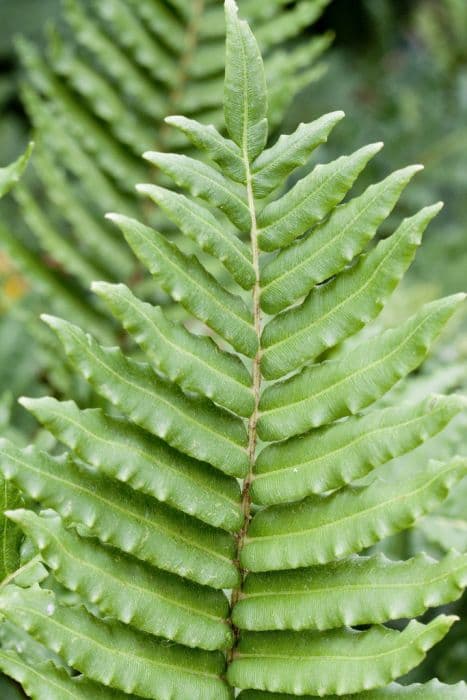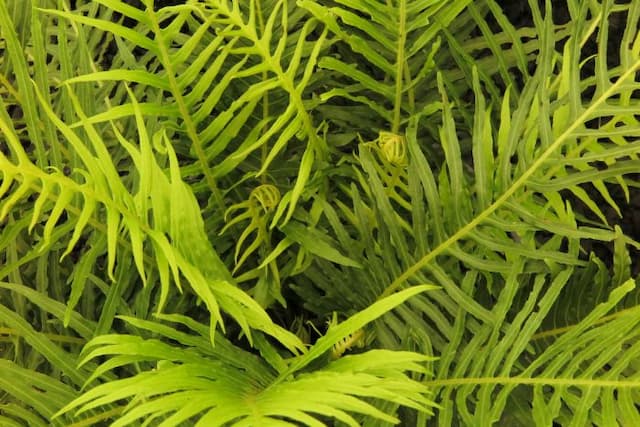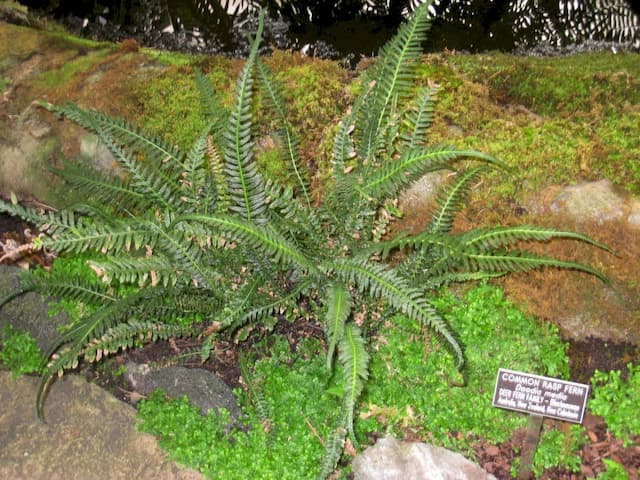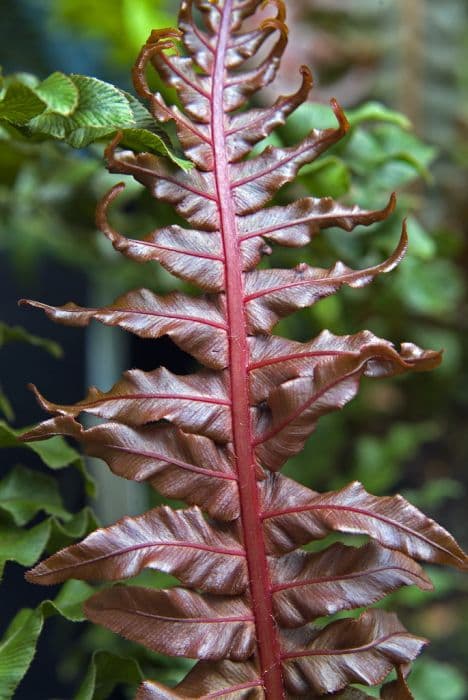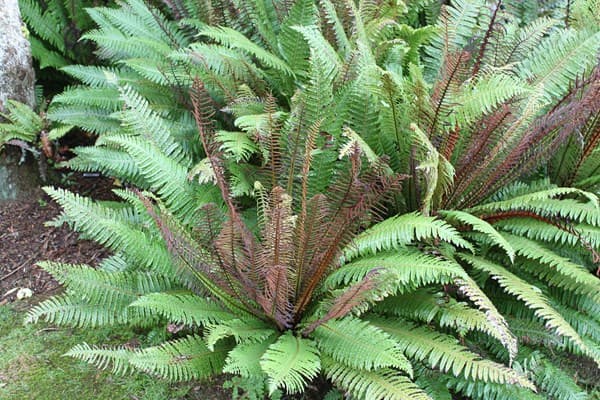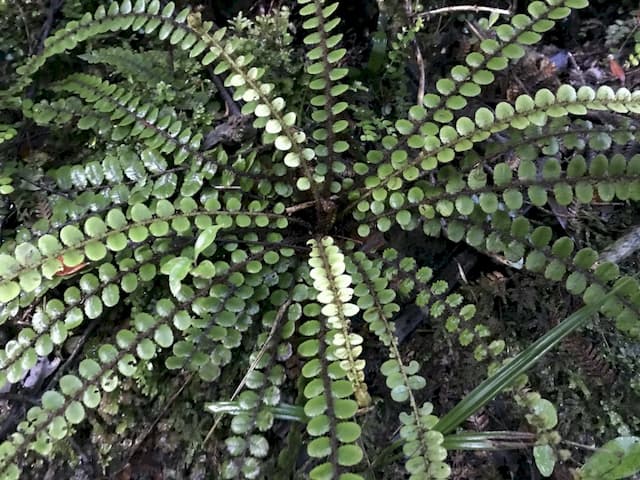Giant Chain Fern Woodwardia unigemmata
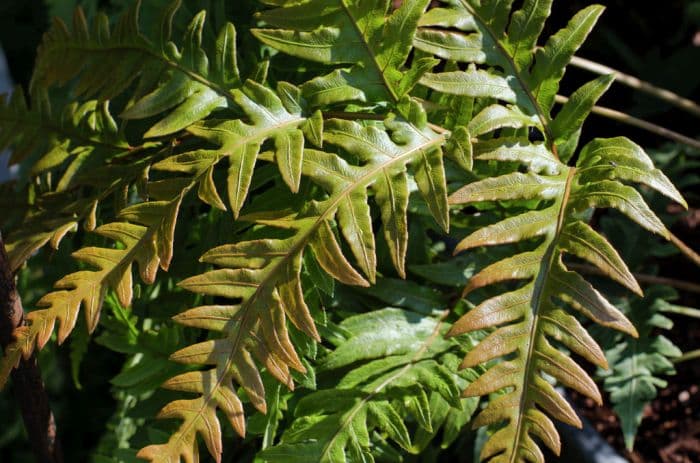
ABOUT
The plant commonly known as the jewel fern is a visually striking species characterized by long, arching fronds. The rich green fronds are distinct for their broad, lance-shaped leaves that line the stems, giving the plant a lush, feathery appearance. The fronds are typically arranged in a rosette pattern, radiating outwards from the center of the plant and creating a textured, voluminous look. Each individual leaf on the frond has a slightly serrated edge, which adds to the intricate detail of the fern's overall appearance. The leaves exhibit a glossy finish, catching the light and creating a vibrant sheen across the surface of the plant. At certain times, small, rounded bulbils can be seen on the fronds, from which new jewel ferns can grow, adding to its unique aesthetic. These bulbils contribute to the plant's ornamental value, making it a favored addition to shaded garden areas. The underside of the fronds may display clusters of reproductive structures, which are typical of fern species, providing a subtle contrast to the bright green of the leaves. Overall, the jewel fern presents a luxurious and verdant presence with its elegant fronds and full-bodied appearance.
About this plant
 Names
NamesFamily
Blechnaceae
Synonyms
Jewel Fern, Chinese Chain Fern
Common names
Woodwardia orientalis, Lorinseria areolata, Woodwardia radicans.
 Toxicity
ToxicityTo humans
Woodwardia unigemmata, commonly known as the jewel fern, is not widely documented for its toxicity to humans. There is limited information available suggesting that it is hazardous when ingested. However, as a general precaution, it is advisable to avoid consuming parts of ornamental plants due to the potential for unknown toxins. If someone were to ingest jewel fern and experience symptoms such as nausea, vomiting, or diarrhea, it is important to seek medical advice.
To pets
The jewel fern (Woodwardia unigemmata) has no known specific toxicity towards pets such as cats and dogs. However, the lack of data means that its safety can’t be guaranteed. If a pet were to consume part of the jewel fern, monitoring for signs of gastrointestinal distress, including vomiting or diarrhea, is recommended and contacting a veterinarian if any symptoms arise. It's generally advisable to prevent pets from ingesting plants not specifically known to be safe.
 Characteristics
CharacteristicsLife cycle
Perennials
Foliage type
Evergreen
Color of leaves
Green
Height
2-3 feet (0.6-0.9 meters)
Spread
2-3 feet (0.6-0.9 meters)
Plant type
Fern
Hardiness zones
7
Native area
China
Benefits
 General Benefits
General Benefits- Ornamental Value: Woodwardia unigemmata, commonly known as the jeweled chain fern, adds aesthetic appeal to gardens with its large, lush, and glossy fronds.
- Habitat Restoration: This fern can be used in reforestation projects and natural landscaping to rehabilitate degraded environments.
- Erosion Control: With its extensive root system, the jeweled chain fern can help stabilize soil and prevent erosion on slopes.
- Biodiversity Support: By providing habitat, the jeweled chain fern supports a variety of insects and animals, contributing to ecological diversity.
- Shade Tolerance: This plant thrives in shady conditions, making it suitable for under-planting in woodland gardens or shaded areas.
- Low Maintenance: Once established, Woodwardia unigemmata is relatively easy to care for, requiring minimal attention beyond ensuring adequate moisture.
 Medical Properties
Medical PropertiesThis plant is not used for medical purposes.
 Air-purifying Qualities
Air-purifying QualitiesThis plant is not specifically known for air purifying qualities.
 Other Uses
Other Uses- Artistic Inspiration: The complex structure and vibrant green of chain fern fronds are often used as inspiration in art and photography, capturing the essence of natural beauty and design.
- Erosion Control: The robust root system of chain ferns can help stabilize soil in areas susceptible to erosion, contributing to environmental conservation efforts.
- Education: Chain ferns can be used as educational tools in botany and ecology classes to illustrate plant life cycles and fern reproduction.
- Cultural Symbolism: In some cultures, chain ferns may represent certain aspects of folklore or be used in traditional ceremonies as symbols of new beginnings or growth.
- Biological Indicator: Chain ferns can serve as indicators of environmental health in an ecosystem, as their presence often signals a well-balanced, humid biome.
- Garden Architecture: Chain ferns can be utilized in landscape design to create natural arches or borders due to their size and shape.
- Craft Material: The dried fronds of chain ferns can be used in crafts for making eco-friendly decorations or as part of natural weavings.
- Film and Theatre: Chain ferns can be used as set decor in film and theatre productions to create realistic forest scenes or enchanted garden backdrops.
- Sound Absorption: Dense chain fern thickets may help reduce noise pollution in high-traffic garden areas by absorbing and diffusing sound waves.
- Companion Planting: Chain ferns can be intentionally planted alongside certain water-loving plants to create a micro-habitat that maintains higher local humidity levels.
Interesting Facts
 Feng Shui
Feng ShuiThe plant_name is not used in Feng Shui practice.
 Zodiac Sign Compitability
Zodiac Sign CompitabilityThe plant_name is not used in astrology practice.
 Plant Symbolism
Plant Symbolism- Resilience: As a hardy fern that can thrive in challenging conditions, Woodwardia unigemmata, commonly known as the "Jeweled Chain Fern," often symbolizes resilience and the ability to persevere through hard times.
- Growth: The fern's growth pattern, where new fronds emerge from the rhizome, represents new beginnings and growth, making it a symbol of personal or spiritual development.
- Endurance: Jeweled Chain Ferns can live for many years, signifying endurance and the continuity of life.
- Persistence: This plant's ability to produce new shoots even in unfavorable conditions aligns it with the theme of persistence and determination.
- Shelter: Ferns in general offer shade and shelter in forests; thus, they embody protection and the concept of providing comfort to others.
 Water
WaterThe Woodwardia unigemmata, commonly known as the Chain fern, requires consistent moisture but should not be waterlogged. Water the Chain fern deeply once a week, ensuring that the soil is thoroughly soaked, which could amount to about 1-2 gallons depending on the size of the plant and the environmental conditions. During hot, dry periods, watering frequency may increase to twice a week. Reduce watering in the winter months to prevent the soil from becoming too soggy, as this can lead to root rot.
 Light
LightChain fern thrives in partial to full shade conditions, avoiding direct sunlight which can scorch its leaves. The best spot for the Woodwardia unigemmata is in an area with dappled sunlight or a location that receives morning light and afternoon shade. Ensure that the plant is protected from harsh afternoon sun, which can be too intense for its delicate fronds.
 Temperature
TemperatureWoodwardia unigemmata prefers temperate climates with temperatures ranging between 60 to 75 degrees Fahrenheit for optimal growth. The Chain fern can tolerate minimum temperatures down to about 20 degrees Fahrenheit, but should not be exposed to prolonged periods of frost. In regions with hotter climates, ensuring adequate shade and moisture is crucial to prevent the fronds from drying out.
 Pruning
PruningPruning the Woodwardia unigemmata is not frequently necessary, but dead or damaged fronds can be removed to maintain plant health and aesthetics. The best time to prune the Chain fern is in the late winter or early spring before new growth begins. Pruning can be done annually or as needed to remove any unsightly foliage and to encourage fresh, healthy growth.
 Cleaning
CleaningAs needed
 Soil
SoilThe Jewel Fern prefers a rich, well-draining soil mix with high organic matter content, ideally a mix of peat, pine bark, and perlite in equal parts. The ideal soil pH for Jewel Fern is between 5.5 and 6.5 to thrive.
 Repotting
RepottingJewel Ferns do not need frequent repotting; it's typically done every 2 to 3 years or when the plant outgrows its container. Preferably repot in the spring.
 Humidity & Misting
Humidity & MistingJewel Fern thrives in high humidity environments, ideally between 60% and 80%. Too low humidity can cause frond tips to brown.
 Suitable locations
Suitable locationsIndoor
Provide bright, indirect light and high humidity for indoor Jewel Ferns.
Outdoor
Plant in shade to part-shade, moist soil, and ensure high humidity for outdoor Jewel Ferns.
Hardiness zone
7-10 USDA
 Life cycle
Life cycleThe Jewel Fern (Woodwardia unigemmata) begins its life cycle when spores, located on the underside of mature fronds, are released to the environment. These spores germinate in moist conditions to form a small, heart-shaped gametophyte, which houses both male and female reproductive organs. Fertilization occurs when sperm from the male organs swim to the female organs in the presence of water, leading to the development of a new diploid sporophyte—the leafy fern plant we recognize. The young sporophyte emerges from the gametophyte and eventually develops roots, fronds, and a rhizome as it matures. As a perennial, the Jewel Fern goes through a period of dormancy during colder months and resumes growth in the spring. This cycle of spore production, gametophyte development, fertilization, and sporophyte growth repeats itself, allowing the Jewel Fern to propagate and survive in its environment.
 Propogation
PropogationPropogation time
Spring-Early Summer
Propogation: Woodwardia unigemmata, commonly known as the Jewel Fern, is typically propagated through spores. The best time to collect spores for propagation is when they are ripe, usually during the summer months when the undersides of the fronds turn brown. To propagate Jewel Fern from spores, one must carefully collect the spores by cutting a frond and placing it spore-side down on a piece of paper to dry. After a few days, the spores will have fallen from the frond and can then be sown on the surface of a sterilized peat and perlite mixture kept consistently moist and in a warm, shaded environment. Patience is vital, as it can take a few weeks to several months for spores to germinate and even longer for the seedlings to grow to a transplantable size.
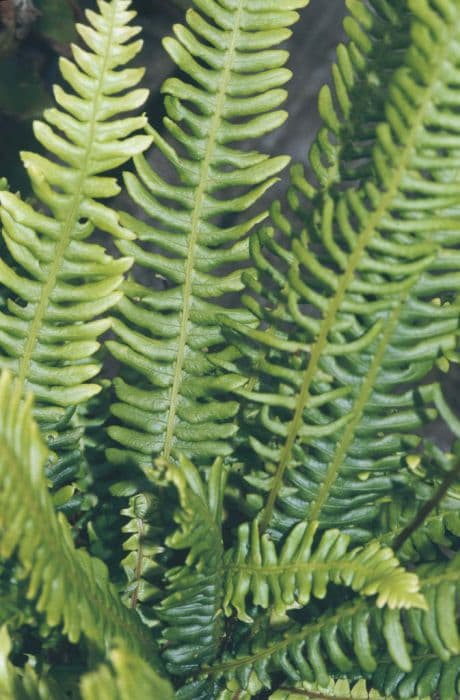
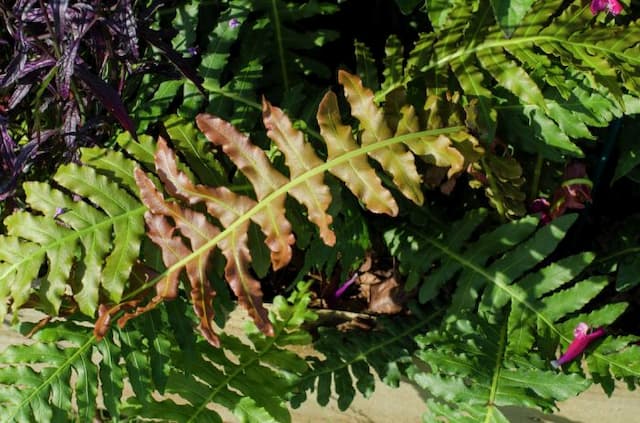
![Dwarf Brazilian tree fern [Eruption]](/_next/image?url=https%3A%2F%2Fplants-admin.emdemapps.com%2Fimages%2Fplants%2F%2Fimages%2F604b5592bbce2.png&w=640&q=75)
